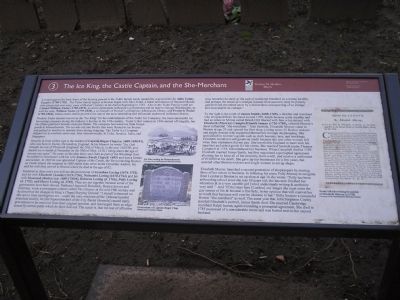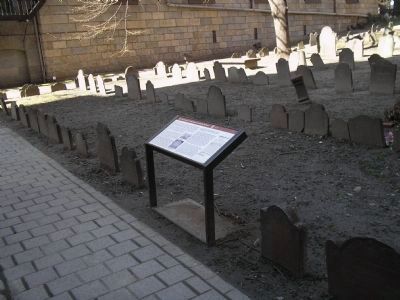Downtown in Boston in Suffolk County, Massachusetts — The American Northeast (New England)
The Ice King, the Castle Captain, and the She-Merchant
Inscription.
Located against the back fence of the burying ground is the Tudor family tomb, marked by a gravestone for John Tudor, Esquire (1709-1795),. The Tudor family legacy began with John Tudor, a baker and deacon of Second Church, who chronicled over sixty years of Bostonís history in his diaries beginning in 1732. Also in the Tudor Family tomb are Colonel William Tudor (1750-1819), an active participant in Bostonís government and an aide to George Washington, as well [as] his sons, William Tudor (1779-1830), a co-founder of Bostonís prestigious Athenaeum library, and Frederic Tudor (1783-1864), whose career choice proved to be one of the most influential endeavors in Boston history.
Frederic Tudor became known as the “Ice King” for his establishment of the Tudor Ice Company, the most successful ice harvesting company during the industryís heyday in the 19th century. Tudorís first venture in 1806 started off roughly, but his efforts gradually became more profitable. The company harvested ice from frozen ponds in Massachusetts. The ice was cut into blocks that were floated to ice houses and packed in sawdust to insulate them during shipping. The Tudor Ice Company shipped ice to southern states and, later internationally, to Cuba, Jamaica, India, and Singapore.
Directly in front of this sign is the marker of Captain Roger Clap (ca. 1609-1690/91), who was born in Exeter, Devonshire, England. In his Memoir he wrote “So, God brought me out of Plymouth [England] the 20th of March, in the year 1629/30, and landed me in health at Nantasket on the 30th of May, 1630, I being about the age of twenty-one years.” He came on the ship Mary and John as part of the Winthrop fleet. He settled in Dorchester with his wife Joanna (Ford) Clap (d. 1695) and was a farmer and soldier. In 1665 he was appointed Captain of the Castle, the fort protecting Boston on Castle Island. He resigned in 1686 rather than serve under Governor Andros. He and his wife then moved to Boston where he died at the age of 82.
Scattered in these rows you will see the gravestone of Jonathan Loring (1674-1752) and his wife Elizabeth (Austin) (1673-1756), Nathaniel Loring (1670-1744) and his wife Susannah (Butler) (ca. 1680-1745/6), Rebecca Loring (d.1766), Polly Loring (d. 1792), and Henry Loring (d. 1793). They are not together because some of the gravestones have been moved. Nathaniel Ingersoll Bowditch, Boston lawyer and historian, wrote a newspaper column called The Gleaner in the mid-19th century and he described the changes to Kingís Chapel Burying Ground: “I myself witnessed on this spot a truly sacrilegious act . . . under the
very windows of the [Massachusetts] historical society, he [the Superintendent of the City Burial Grounds] caused many gravestones to be removed from their original position, and rearranged them as edgestones by certain paths which he there laid out. The result is, that the tear of affection may hereafter be shed; or the sigh of sentiment breathed, in a wrong locality, and perhaps the bones of a stranger instead of an ancestor, may be piously gathered and entombed anew by a descendant, unsuspecting of so strange and inexcusable an outrage.”
To the right is the tomb of James Smith (1689-1769), a distiller and merchant who emigrated from Scotland around 1709. Smith became quite wealthy and had an estate in Milton called Brush Hill. Buried with him is his second wife Elizabeth (Murray) Campbell Smith Inman (1726-1785), colonial Bostonís most influential “she-merchant.” Also Scottish, Elizabeth Murray came to Boston at age 23 and opened her first shop, joining some 35 Boston widows and single women who supported themselves through shopkeeping. She specialized in womenís goods such as cloth bonnets, lace, and stockings. Elizabeth would not sell goods on credit because she saw other women fail when their customers did not pay. She traveled to England to meet with her suppliers and select goods for her stores. She married Scottish trader Thomas Campbell in 1755, but continued her business. When Campbell died in 1759 Elizabeth married James Smith, but first negotiated a prenuptial agreement allowing her to keep all of her property, have a will, and receive a settlement of £10,000 at his death. She gave up her business for a few years, but assisted other Boston widows and single women to set up shops.
Elizabeth Murray launched a second generation of shopkeepers by starting three of her nieces in business. In lobbying for niece Polly Murray to emigrate from London to Boston to set up shop at age 16 she wrote: “Polly has been at boarding school since she was 10 years old; she has now finished her education & is a very capable girl [who] understands writing & arethmitc very well.” And “if she stays here [London] any longer she must enter the gay scenes of life & become a fine lady, in my opinion that will enervet her so much that business will ever be irksome to her.” Polly became a successful Boston “she-merchant” as well. The same year that John Singleton Copley painted Elizabethís portrait, James Smith died. She married Cambridge merchant Ralph Inman, again executing a prenuptial agreement. She died in 1785 possessed of a considerable estate and was buried next to her second husband.
Topics. This historical marker is listed in these topic lists: Cemeteries & Burial Sites • Colonial Era • Women. A significant historical date for this entry is May 30, 1630.
Location. 42° 21.491′ N, 71° 3.579′ W. Marker is in Boston, Massachusetts, in Suffolk County. It is in Downtown. Marker can be reached from Tremont Street, on the right when traveling north. Marker is located along the walking trail in Kingís Chapel Burying Ground, at the back of the cemetery. Touch for map. Marker is in this post office area: Boston MA 02108, United States of America. Touch for directions.
Other nearby markers. At least 8 other markers are within walking distance of this marker. William Dawes Jr. (a few steps from this marker); Pilgrims and Patriots (a few steps from this marker); The First Governor (within shouting distance of this marker); Benjamin Franklin (within shouting distance of this marker); Welcome to Kingís Chapel Burying Ground (within shouting distance of this marker); Kingís Chapel Burial Ground (within shouting distance of this marker); Boston Public Latin School (within shouting distance of this marker); Electric Fire Alarm System, 1852 (within shouting distance of this marker). Touch for a list and map of all markers in Boston.
More about this marker. The right side of the marker contains a reproduction of a “Trade bill advertising broadside of Elizabeth Murray [c. 1750], courtesy of the Massachusetts Historical Society.” The center of the marker features a picture of “Ice Harvesting in Massachusetts, courtesy of the Massachusetts Historical Society” and a photograph of the Gravestone of Captain Roger Clap, provided by Viamonte Design.
Related markers. Click here for a list of markers that are related to this marker. Take a tour of the markers found in Kingís Chapel Burying Ground.
Also see . . . King's Chapel and Burying Ground. Details of the Freedom Trail from the City of Boston website. (Submitted on May 15, 2009, by Bill Coughlin of Woodland Park, New Jersey.)
Credits. This page was last revised on January 30, 2023. It was originally submitted on May 15, 2009, by Bill Coughlin of Woodland Park, New Jersey. This page has been viewed 1,767 times since then and 20 times this year. Photos: 1, 2. submitted on May 15, 2009, by Bill Coughlin of Woodland Park, New Jersey.

